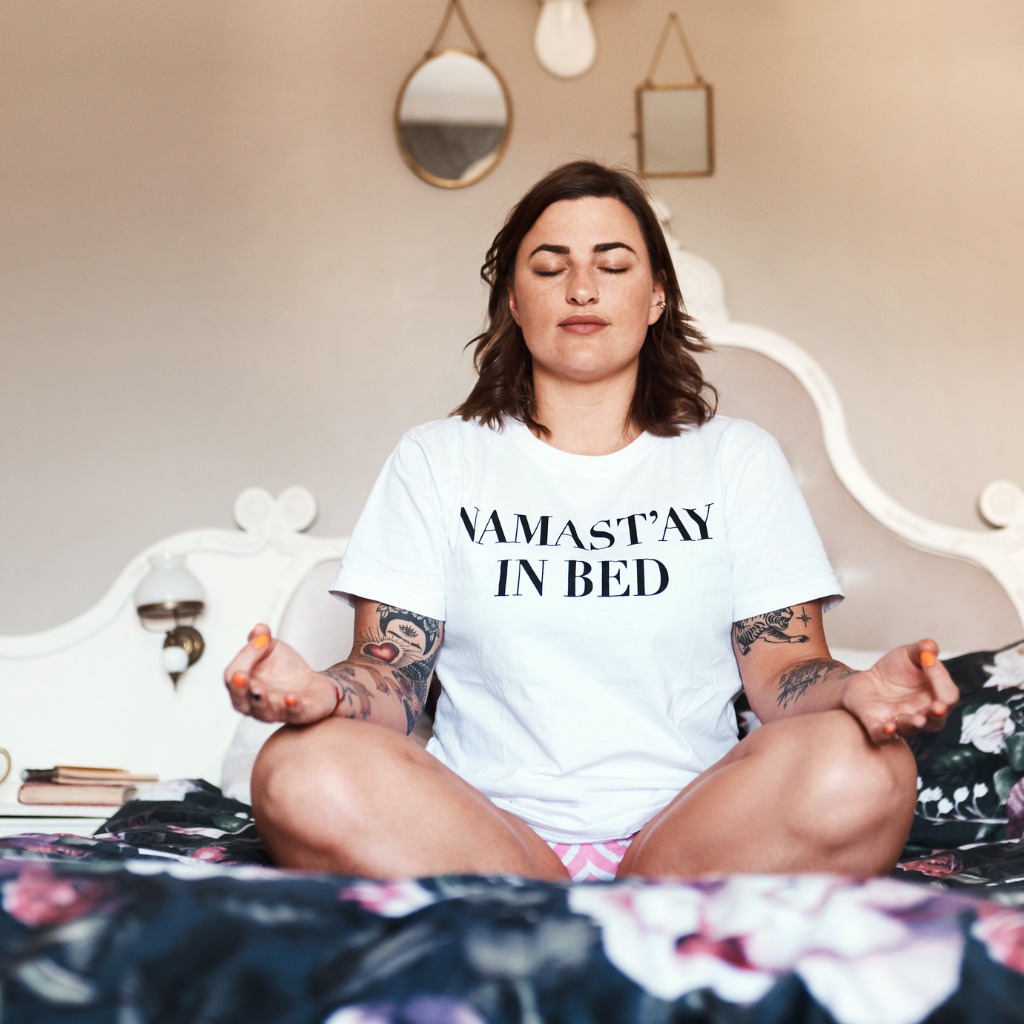Do you want to sleep better? Reduce stress, anxiety, and depression? Improve focus, concentration, and resilience? Then you need to develop a meditation practice ASAP. And it’s not even difficult, especially if you learn how to meditate in bed.
Why Meditate in Bed?
There are many good reasons to learn how to meditate in bed. First off, your bed is safe, comfortable, and familiar, which helps get you into the right physical and mental state.
If you choose to meditate when you wake up, it can put you in a good mindset for the day. If you choose to meditate at night, it can help you drift off and improve the quality of your sleep (just one of the many benefits of meditation).
Another good reason to meditate in bed is that it can help you build a regular meditation habit. Linking behaviors to a particular cue or trigger in your environment or routine can be a huge help in developing a new habit. (Charles Duhigg talks about this in his best-selling book “The Power of Habit.”) You can make this work for you by tying your meditation practice to an environment where you already spend time every day (your bed) and events in your existing routine (waking up or going to sleep).
Do it enough times, and you’ll get to the point where meditating becomes practically automatic, like brushing your teeth.
How to Meditate in Bed
Meditating in bed is easy! Here are the ins and outs on how to meditate in bed for beginners:
Get Ready
Whether you meditate in the morning upon waking or before drifting off to sleep, make sure you’re in the best physical and mental state for meditation. Dress comfortably, get in a supportive position (lying down or sitting up), and block out noise and distractions by shutting the door and silencing your cell phone. Use a sleep mask and earplugs or earbuds, too, if that helps you.
Choose Your Meditation Style
Meditation comes in many different forms. There’s a common misconception that to meditate correctly, you need to empty your mind of all thoughts and keep it empty. But that’s not true. Meditation is ultimately a practice that seeks to calm the mind and temporarily stop (or at least reduce) the constant “chatter” of unwelcome and intrusive thoughts that can cause stress and anxiety. Fortunately, there are many ways to do this.
Below are some of the more popular and beginner-friendly types of meditation. Choose the kind that sounds most appealing to you and try it; try out different types of meditation until you find one you click with.
Guided meditation
Listen to a recording that guides you through meditation step by step. This is one of the easiest types of meditation to get started with. There’s no work on your part other than choosing the guided meditation track to listen to. You can find plenty of free guided meditations of different lengths online and via apps on your phone, some of which have paid options for more perks.
Mindful meditation
Meditation is often combined with mindfulness, the practice of being fully aware in the present moment. To do mindful meditation, keep your attention on what’s happening right now, and don’t become distracted by thoughts about the past or the future. If they enter your mind, note them without judgment, and allow them to leave again. For now, all you care about is what’s happening in this moment.
Breathing meditation
Breathing meditation is a variation of mindful meditation in which you pay attention to your breath. There’s no need to do any special kind of breathing. Just breathe as usual, but pay attention to the inhale, the exhale, how your chest and abdomen move, how the air feels going in and out of your nose and lungs, and so on.
Mantra meditation
Choose a word or phrase that’s meaningful to you and repeat it for the duration of your meditation session. “Om” (or “aum”) is a well-known mantra which has significance in Hinduism and Buddhism. You may want to repeat a single word like “love,” “peace,” or “patience,” or a phrase of affirmation, such as “I am capable and resilient” or “I am grateful and open to new experiences.”
Visual meditation
Visualize a peaceful, stress-free scene in your mind during your meditation. Perhaps you’re walking through a quiet forest beside a babbling brook, standing beneath the waters of a tropical waterfall, or scrunching your toes in the sand on the beach. Use all five of your senses in your visualization to make it as real as possible in your mind.
Body scan meditation
Turn your attention to every part of your body in turn, going from head to toe or toe to head. Notice the sensations in each body part, its position, weight, and anything else that catches your attention.
Progressive muscle relaxation meditation
This is similar to a body scan in that you go through your entire body part by part. But in progressive muscle relaxation, you tense up each muscle and relax it along the way. This is a great way of relieving tension in parts of your body that you didn’t even know were tense.
Metta meditation (loving-kindness meditation)
Fill yourself with a feeling of love and kindness directed towards yourself. Then move those feelings of love and kindness outwards to other people – family, friends, even people you have conflict with. You might imagine a ray of colored light connecting you and another person, transmitting your feelings of loving kindness to them.
Now, Meditate!
After you’ve chosen your style, it’s finally time to meditate.
How long should you meditate? For a morning meditation in bed, you might want to try 5-10 minutes to start and work your way up to 15-45 minutes a day. And hey, if even 5 minutes is too much, start with 2 or 3 minutes!
At the beginning, developing a habit is the most important thing you can do. You can lengthen your meditation sessions as you get better. If you meditate at night, you might not even make it 5 or 10 minutes before falling asleep.
That’s all there is to it. It’s not difficult to learn how to meditate in bed, even for beginners. It’s a great way to make use of your time and reap the many benefits of meditation – all from the cozy comfort of your own bed!

Erin Danly is a freelance writer whose work focuses on marketing content and verbal branding for B2B and B2C clients. Before turning to writing, she was a pastry chef and a psychology lab manager at Columbia University. Erin lives with her family in Mt. Pleasant, SC.






